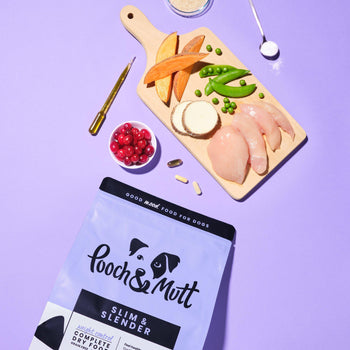Have you noticed your dog getting fatty lumps and bumps under their skin?
It’s normal for dogs to get lumps as they get older, and you’re not alone if they trigger worry and concern.
Though lumps can point to cancer, they can also be harmless or linked to other, less serious health issues. Either way, getting your pooch seen by a vet is essential.
In this article, we’ll explain how to check your dog for lumps, what to do if you find lumps on your dog, and what different kinds of lumps and bumps can mean for their health.
What are fatty lumps on dogs?
Fatty lumps can develop anywhere on your dog’s body, and many won’t seem to bother your dog at all.
They are usually soft, squishy mounds, like a small water balloon, that form under your dog’s skin.
Some may seem to ‘move’ under the skin when you gently press them, and are usually painless - though your dog may not like them being touched.
Others may be harder, or smaller, or painful for your pooch, and this is why it’s important to get all lumps checked.

What do lumps on my dog mean?
It’s tricky to assess exactly what lumps on your dog mean, as they can point to a few different health issues or could be harmless.
Though the most severe conclusion is that a lump is cancerous (malignant), sometimes lumps are simply signs of ageing or a side effect of weight gain.
The most important thing is to get all lumps checked out by a vet, as it’s impossible to know what a lump can mean just by inspecting it yourself.
Can you tell the difference between fatty and cancerous lumps on dogs?
It's impossible to tell the difference between a benign and cancerous lump on your dog just by looking or feeling.
When you find a lump on your dog, book an appointment with your vet as soon as you can. More often than enough, it's all good, but it's always good to do the right checks to rule out the worst.
Where do lumps commonly show up on dogs?
Lumps can appear anywhere on your dog’s body, but they are more commonly seen in certain areas, such as;
- Chest
- Abdomen
- Legs and paws
- Neck and shoulders
- Under their armpits
- Base of their tail
We recommend doing regular full-body checks to inspect for lumps on your dog, as they can also show up in unexpected or hidden places.
What are the common types of lumps on dogs?
-
Lipomas are soft, round, fatty lumps that are usually painless.
You’ll find these kinds of lumps are common in ageing or overweight dogs, particularly in breeds such as Labradors, Golden Retrievers, Dobermans, Miniature Schnauzers, Poodles or Springer Spaniels - though all breeds can get them.
Lipomas are made of almost entirely fat cells and are usually benign but all lipomas will need checking by a vet.
-
Sebaceous cysts are much smaller, fluid-filled bumps that form from blocked skin glands.
They can resemble a pimple or wart, and will sometimes pop - though they also may stay unchanged for an extended time.
Sebaceous cysts usually aren’t serious, but they can become infected, so it’s worth showing any cysts like this to your vet.
-
Abscesses are usually caused by infection and can be painful.
Often forming from insect stings, infected glands or other animal bites, an abscess may be liquid-filled or bloody.
These require a close eye on bumps and a visit with your vet as they’re ripe for bacteria and will worsen if not treated.
Don’t burst them unless it happens naturally - this can make the infection worse.
-
Histiocytomas can also be called Button Tumours.
These typically affect younger dogs under 3 years old.
They look like small pink mounds on the skin, and often end up shrinking on their own as your dog grows. But always check with your vet, just to be sure!
-
Mast cell tumours are cancerous, and unhelpfully, these tumours can all look different.
They’re usually pink lumps that can appear anywhere on the body, from the paws to the groin, face or legs.
As they’re hard to detect, you should get your dog checked by a vet as soon as you notice one.

How to feel for cancerous lumps on your dog
Even if you think it’s probably nothing, no lump on your dog should be ignored.
It’s vital to take your pooch to a vet to get lumps checked over.
As part of your routine, always check for potential lumps on your dog so you can get ahead of any health conditions and seek the right treatment for them.
A great way to kick off your check is to work at their head and work your way to their tail.
Gently feel for lumps and bumps, focusing on areas where lumps commonly crop up (but remember, lumps can appear anywhere!).
Have a feel of their face, ears, chest, armpits, sides, back, tummy and don’t forget to take a look at their genital area.

How do vets diagnose lumps in dogs as cancer or benign?
Your vet could use several methods to determine whether your dog’s fatty lump(s) are harmless or point to an issue.
- Firstly, they’ll physically examine the lump to check its size, shape, texture and whether it’s hard or malleable.
- They may perform a fine needle aspiration (FNA), or a biopsy, where they extract some of the cells from the lump to analyse under a microscope.
- Sometimes, your vet might suggest an X-ray or ultrasound to analyse deeper tissue, or they may give your dog a blood test.
- Your pooch might get a lump removed if it’s at risk of becoming cancerous, or if it’s causing pain or discomfort to them.
Remember, no lump can be diagnosed without professional veterinary testing, so it’s not recommended to ever assess fatty lumps on your own.
Can you prevent dogs from developing lumps?
Lumps form on dogs for many reasons, so there’s no way to prevent them completely.
However, as benign fatty lumps are more common in overweight dogs, there are some lifestyle tweaks you can make to help keep them at bay.
Make sure your pooch gets enough exercise, and feed them a well-balanced, nutritious diet that’s low in fat but also provides them with everything they need to be their best selves! (And of course, absolutely delicious)
As for other kinds of lumps, these are often warning signs for you that something is going on with your pooch. As soon as you notice any sort of lump, it’s time to take your dog to visit your vet.
What diet can help prevent lumps in dogs?
A well-balanced and nutritious diet can work wonders for your pooch’s health.
It keeps them high energy, strong, lean and helps reduce the chance of fatty lumps developing.
This diet should be full of whole proteins, vitamin-rich fruit and vegetables and gut-friendly supplements, such as prebiotics and probiotics and omega-3 fatty acids.
A specialist dog food that promotes good skin and coat health can help your pooch feel comfortable in their skin whilst helping with symptoms that can come along with lumps and bumps including itchiness, redness, flare-ups and lumps and bumps.
How to monitor for lumps in your dog
Like with many other health conditions, catching it early can make it easier to treat. So, be sure to make checking your dog for lumps and bumps a part of your routine - just like their grooming or brushing their teeth!
You can do this by:
-
Check their body regularly. Lumps can go unnoticed on your pooch if they’re in hidden places, such as the armpit, groin, or behind the ears or collar - so give your dog body checks regularly by gently moving your hands over their skin, paying attention to particularly fluffy areas. A few healthy dog treats can keep them calm and steady as you do this.
-
Note when lumps disappear, and when new ones appear. Your dog might have a benign lump that they’ve had for a while, but still don't hesitate to investigate this.
Pay attention to if and when lumps disappear, and when new ones develop.
-
Pay attention to changes in lumps, particularly if:
- A lump grows rapidly in size
- It seems to be painful, bleeding or leaking
- It feels hot, or is red or flushed
All of these changes will require an urgent vet check-up.
-
Never ignore lumps and bumps. No matter how harmless you believe a lump to be, ignoring it can be dangerous or even fatal.
Always speak to your vet.
What are other symptoms to look out for?
As well as staying alert to lumps, you should take note of any other symptoms your dog is showing and let your vet know.
This includes changes in your dog’s behaviour such as:
- Aggressiveness
- A lack of energy or lethargy
- If they’ve been sick
- Suffering a fever
- If they’ve lost weight and/or lost interest in their food.
All of this extra information can help your vet make a proper diagnosis.
FAQs
Do lipomas in dogs go away on their own?
No, not usually. Lipomas are usually benign, but they tend to stick around unless your vet suggests removing them.
Even if diagnosed as safe, you’ll need to keep an eye on these in case they change.
Tell your vet if there is any cause for concern (such as if the lump grows quickly, becomes infected or causes your dog pain).
Are cancerous lumps on dogs hard or soft?
There isn’t any rule that says a hard or soft lump is definitely cancer, though cancerous lumps are often harder and attached to the skin tissue.
Some softer lumps that move under the skin can also become cancerous (malignant), though it’s rare. Whether a lump is hard or soft, make sure your vet gets to examine the lump so they can rule out anything serious.
Why do dogs get lumps as they age?
As dogs get older, their bodies shift and change, just like ours.
Fatty tissue, glands and skin cells can form lumps under the skin, which may look concerning, but they’re often harmless and benign.
The key thing to remember is that as dogs age, their risk of developing cancer also increases, so it’s super important to monitor your pooch’s lumps and book regular vet check-ups to keep on top of these bodily changes.
For grain-free dog food that reduces fatty lumps, our Pooch & Mutt Skin & Coat range is packed full of smart, grain-free recipes and powerful supplements to promote a shiny coat and healthy skin, as well as good mood and gut-friendly activity














Comments (0)
Leave a comment